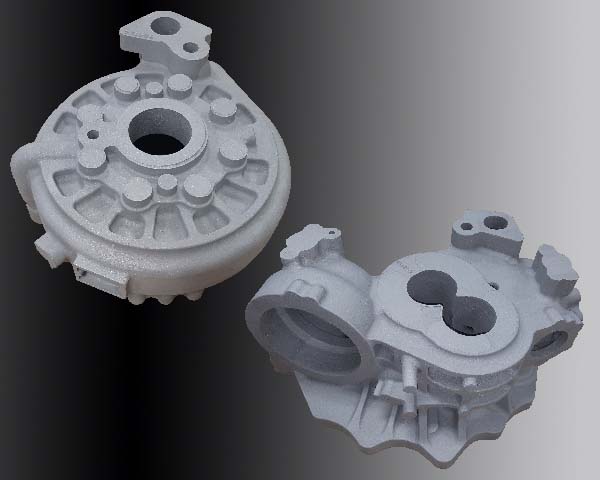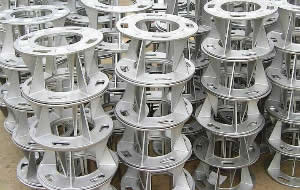Explained: Aluminum Foundry Techniques and Their Advantages
Aluminum Casting Explained: Key Realities and Insights for Market Professionals
Aluminum casting works as a crucial procedure in contemporary production, forming elements throughout different industries. Its diverse approaches, such as sand and die casting, satisfy different production requirements. The unique properties of aluminum alloys improve their applicability, yet challenges continue to be in keeping quality and efficiency. Comprehending these elements is important for industry specialists. What are the most up to date advancements and best techniques that can further maximize this process?
Review of Aluminum Casting Processes

Crucial element of aluminum casting procedures include the prep work of mold and mildews, which might be made from sand, steel, or ceramic products, depending on the intended use. Furthermore, temperature control is vital to guarantee appropriate melting and solidification of aluminum.
The casting process enables intricate layouts and can attain high degrees of dimensional precision. When cooled down, the castings might undertake completing procedures such as machining or surface area therapy to meet details efficiency criteria. Generally, aluminum casting offers as a flexible production method, properly satisfying the diverse needs of different sectors.
Sorts Of Aluminum Casting Methods
In the domain of aluminum casting, different methods are utilized to attain different results. Sand casting strategies supply versatility and cost-effectiveness for complicated forms, while die casting processes offer high accuracy and performance for automation. Comprehending these approaches is vital for choosing the suitable technique based upon task requirements.
Sand Casting Methods
Sand casting techniques represent an essential approach in aluminum casting, where sand is made use of as a mold product to form molten metal. This process entails producing a pattern from the wanted part, which is then positioned in a sand mix to develop a mold. The sand is compressed around the pattern, and after elimination, it develops a dental caries in the shape of the component. Molten aluminum is poured right into this dental caries, allowing it to solidify and cool down. One significant benefit of sand casting is its versatility; it can fit huge elements and complex shapes. Furthermore, the products utilized are relatively inexpensive, making it an obtainable option for various manufacturing applications in the aluminum market.
Die Casting Processes
Die casting processes are a noticeable approach for shaping aluminum components, utilizing high-pressure strategies to force molten metal right into exactly engineered molds. This procedure is specifically preferred for its ability to create complex forms with tight resistances and a smooth surface. There are 2 main sorts of die casting: warm chamber and cold chamber. Hot chamber die casting is ideal for steels with reduced melting points, enabling for faster manufacturing rates. Alternatively, chilly chamber die casting is excellent for higher melting factor steels, requiring a separate melting heating system. Both techniques boost performance and decrease product waste, making them essential in auto, aerospace, and durable goods industries. Comprehending these processes assists specialists select the most proper strategy for their details applications.
Material Feature of Aluminum Alloys

Toughness and Longevity
Stamina and durability are critical attributes of aluminum alloys that make them ideal for various casting applications. These products display a favorable strength-to-weight proportion, allowing for the creation of lightweight yet durable elements. When it come to tensile strength, certain aluminum alloys can be engineered to stand up to considerable tons without deforming. This property is especially essential in sectors such as aerospace and vehicle, where efficiency and safety and security this article are extremely important. Additionally, aluminum alloys usually keep their mechanical homes under varied temperature problems, ensuring constant performance. The intrinsic ductility of these alloys likewise permits efficient shaping throughout the casting process, making it easier to produce complex geometries. In general, the stamina and durability of aluminum alloys contribute considerably to their extensive usage in innovative applications.
Corrosion Resistance Characteristics
While aluminum alloys are treasured for their strength and lightweight properties, their deterioration resistance is another crucial characteristic that enhances their viability for different applications. Aluminum normally develops a safety oxide layer when revealed to wetness, which aids to avoid more oxidation. This integral property makes aluminum alloys particularly valuable in atmospheres vulnerable to deterioration, such as commercial and aquatic setups. In addition, different alloy make-ups can influence resistance levels, with specific alloys particularly engineered to enhance this particular. Treatments like anodizing can better enhance corrosion resistance by enlarging the oxide layer. Understanding the corrosion resistance of aluminum alloys is necessary for sector specialists when picking products for projects requiring resilience and durability in difficult environments.
Benefits of Aluminum Casting in Manufacturing
Aluminum casting offers various advantages in production, making it a favored selection for numerous markets. One substantial advantage is its lightweight nature, which adds to minimized transportation costs and enhanced power performance in final product. Aluminum's outstanding thermal and electric conductivity boosts capability in applications requiring heat dissipation or electrical conduction.
The material's capability to be cast right into complex forms enables style adaptability, lowering the need for extra machining procedures. In enhancement, aluminum casting exhibits exceptional deterioration resistance, bring about longer item life expectancies and reduced upkeep costs.

Common Applications of Aluminum Castings
The convenience of aluminum casting allows its prevalent usage throughout different markets. Common applications consist of automobile components, where light-weight and corrosion-resistant components, such as engine blocks and transmission housings, boost lorry performance. In the aerospace market, aluminum spreadings are used for architectural components, using strength without adding substantial weight.
Additionally, the electric sector advantages from aluminum spreadings in making units and warmth sinks, where thermal conductivity is vital. The customer products industry additionally includes aluminum spreadings in products like pots and pans, furnishings, and attractive things, combining appearances with capability.
In addition, the construction sector uses aluminum spreadings for architectural aspects, window structures, and components, which supply resilience and style flexibility. In general, the varied applications of aluminum spreadings emphasize their value in modern manufacturing, adding to improvements in performance and item layout across numerous areas.
Advancements and Technical Improvements
As markets remain to evolve, developments in aluminum casting modern technology are changing manufacturing processes and product capacities. Advancements in 3D printing and additive production have actually made it possible for the creation of intricate geometries that were formerly difficult to attain with typical approaches. These technologies enable rapid prototyping, lowering lead times and expenses.
In addition, renovations in mold and mildew layout and materials have enhanced the casting process by increasing try here effectiveness and reducing waste. The assimilation of wise manufacturing techniques, such as IoT tools and real-time information analytics, enables better tracking and optimization of manufacturing criteria, resulting in better outputs.
Developments in aluminum alloys supply improved toughness, rust resistance, and light-weight homes, providing to the growing needs in aerospace and auto sectors. Collectively, these innovations are not just enhancing performance but also satisfying the strenuous criteria of contemporary engineering applications.
Finest Practices for Quality Assurance in Aluminum Casting
Making sure top notch results in aluminum casting needs adherence to best practices that incorporate different stages of the production procedure. First, extensive product examination is vital to verify the quality of aluminum alloys used, as contaminations can substantially influence the last item. Applying exact melting and putting strategies decreases problems; preserving optimal temperatures redirected here prevents oxidation and advertises harmony.
Mold layout plays a crucial role; utilizing computer-aided style (CAD) can improve precision and reduce human error. Normal monitoring of the cooling process is critical to avoid bending and shrinking. Additionally, utilizing non-destructive screening techniques, such as ultrasonic or X-ray evaluations, helps identify inner imperfections without harming the elements.
Establishing a responses loop with drivers and engineers fosters continuous renovation, guaranteeing that quality control measures develop along with technological advancements. By complying with these finest techniques, suppliers can improve the integrity and efficiency of aluminum spreadings.
Frequently Asked Questions
What Are the Environmental Influences of Aluminum Casting?
The ecological influences of aluminum casting include substantial energy usage, greenhouse gas emissions, and prospective water pollution from shop procedures. Additionally, bauxite mining for aluminum ore can cause environment destruction and dirt degradation.
Just How Does Aluminum Casting Contrast to Various Other Metal Casting Procedures?
Aluminum casting usually provides benefits in light-weight parts and rust resistance compared to various other procedures, such as iron or steel casting, which may provide greater toughness however lead to heavier and much less corrosion-resistant products. - Aluminum Foundry
What Prevail Defects in Aluminum Castings and Their Causes?
Common flaws in aluminum castings consist of porosity, shrinking, and inclusions. Causes usually come from incorrect pouring strategies, inadequate mold and mildew design, or contamination of the liquified metal, affecting the last product's honesty and performance.
What Safety and security Safety Measures Should Be Taken Throughout Aluminum Casting?
Throughout aluminum casting, necessary safety and security precautions consist of using safety gear, making certain correct ventilation, keeping a clean work space, managing liquified metal with treatment, and adhering to well established protocols to lessen risks of burns, breathing hazards, and accidents.
Just How Can I Improve the Performance of My Aluminum Casting Procedures?
To improve efficiency in aluminum casting operations, one must optimize mold and mildew design, simplify material handling, utilize automated procedures, conduct regular maintenance on tools, and buy employee training to improve abilities and efficiency.
Numerous methods exist, aluminum casting incorporates several key processes that provide to various applications and needs. Key components of aluminum casting processes consist of the prep work of molds, which might be made from sand, steel, or ceramic products, depending on the intended usage. Sand casting strategies represent a basic technique in aluminum casting, where sand is used as a mold product to shape molten steel. As markets proceed to advance, technologies in aluminum casting modern technology are transforming manufacturing procedures and item capacities. Making certain top notch outputs in aluminum casting requires adherence to finest methods that encompass numerous stages of the manufacturing process.